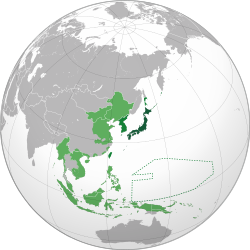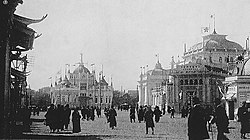 Global Information
Global InformationEmpire of Japan information
Empire of Japan
| |||||||||||||
|---|---|---|---|---|---|---|---|---|---|---|---|---|---|
| 1868–1947 | |||||||||||||
 Flag
 Imperial Seal
| |||||||||||||
| Motto: (1868–1912) 五箇条の御誓文 Gokajō no Goseimon "The Oath in Five Articles" | |||||||||||||
| Anthem: (1869–1945) 君が代 Kimigayo "His Imperial Majesty's Reign" [1][2][a] | |||||||||||||
![Empire of Japan (1 to 6) from the 1910 annexation of Korea until the 1945 surrender.[b]](http://upload.wikimedia.org/wikipedia/commons/thumb/6/68/EmpireOfJapan0.png/250px-EmpireOfJapan0.png) Empire of Japan (1 to 6) from the 1910 annexation of Korea until the 1945 surrender.[b] | |||||||||||||
 Areas de facto controlled by the Empire of Japan at peak in World War II (1942):
| |||||||||||||
| Status | Independent state (1868−1945) Military occupation (1945–1947) | ||||||||||||
| Capital |
| ||||||||||||
| Largest city |
| ||||||||||||
| Official languages | Japanese | ||||||||||||
| Recognised regional languages |
| ||||||||||||
| Religion |
| ||||||||||||
| Government | Unitary absolute monarchy (1868–1889)[7]
Unitary parliamentary semi-constitutional monarchy (1945–1947) | ||||||||||||
| Emperor | |||||||||||||
• 1868–1912 | Meiji | ||||||||||||
• 1912–1926 | Taishō | ||||||||||||
• 1926–1947 | Shōwa | ||||||||||||
| Prime Minister | |||||||||||||
• 1885–1888 (first) | Itō Hirobumi | ||||||||||||
• 1946–1947 (last) | Shigeru Yoshida | ||||||||||||
| Legislature | None (rule by decree) (1868–1871) House of Peers (1871–1889) Imperial Diet (since 1889) | ||||||||||||
• Upper house | House of Peers (1889–1947) | ||||||||||||
• Lower house | House of Representatives (from 1890) | ||||||||||||
| Historical era | Meiji • Taishō • Shōwa | ||||||||||||
• Meiji Restoration | 3 January 1868[9] | ||||||||||||
• Meiji Constitution | 11 February 1889 | ||||||||||||
• First Sino-Japanese War | 25 July 1894 | ||||||||||||
• Russo-Japanese War | 8 February 1904 | ||||||||||||
• World War I | 23 August 1914 | ||||||||||||
• Mukden Incident | 18 September 1931 | ||||||||||||
• Second Sino-Japanese War | 7 July 1937 | ||||||||||||
• Founding of the IRAA | 12 October 1940 | ||||||||||||
• World War II | 7 December 1941 | ||||||||||||
• Surrender of Japan | 2 September 1945 | ||||||||||||
• Reconstituted | 3 May 1947[8] | ||||||||||||
| Area | |||||||||||||
| 1938[10] | 1,984,000[f] km2 (766,000 sq mi) | ||||||||||||
| 1942[11] | 7,400,000[g] km2 (2,900,000 sq mi) | ||||||||||||
| Population | |||||||||||||
• 1920 | 77,700,000a | ||||||||||||
• 1940 | 105,200,000[h]b | ||||||||||||
| Currency |
| ||||||||||||
| |||||||||||||
| |||||||||||||
| Part of a series on the |
| History of Japan |
|---|
 |
|
| Japanese Empire | |||||
|---|---|---|---|---|---|
| Japanese name | |||||
| Hiragana | だいにっぽんていこく だいにほんていこく | ||||
| Katakana | ダイニッポンテイコク ダイニホンテイコク | ||||
| Kyūjitai | 大日本帝國 | ||||
| Shinjitai | 大日本帝国 | ||||
| |||||
| Official Term name | |||||
| Official Term | Japanese Empire | ||||
| Literal Translation name | |||||
| Literal Translation | Imperial State of Greater Japan or the Great Japanese Empire | ||||
The Empire of Japan,[i] also referred to as the Japanese Empire, Imperial Japan, or simply Japan, was the Japanese nation-state[j] that existed from the Meiji Restoration in 1868 until the enactment of the reformed Constitution of Japan in 1947.[8] From 29 August 1910 until 2 September 1945, it administered the naichi (the Japanese archipelago and post-1943 Karafuto) and the gaichi (Korea, Taiwan, Kwantung Leased Territory, and pre-1943 Karafuto). The South Seas Mandate was a single Japanese dependent territory in the name of the League of Nations under Japanese administration. In the closing stages of World War II, with Japan defeated alongside the rest of the Axis, the formalized Japanese Instrument of Surrender was issued in compliance with the Potsdam Declaration of the victorious Allies, and Japanese de facto territory subsequently shrunk to cover only the Japanese archipelago as it is today.
Under the slogans of fukoku kyōhei[k] and shokusan kōgyō,[l] which followed the Boshin War and the restoration of power to the Emperor from the Shogun, Japan underwent a period of large-scale industrialization and militarization, often regarded as the fastest modernization of any country to date. All of these aspects contributed to Japan's emergence as a great power following the First Sino-Japanese War, the Boxer Rebellion, the Russo-Japanese War, and World War I. Economic and political turmoil in the 1920s, including the Great Depression, led to the rise of militarism, nationalism, statism and totalitarianism. This ideological shift eventually culminated in Japan joining the Axis alliance with Nazi Germany and Fascist Italy, and also conquering a large part of the Asia-Pacific.[15] During this period, the Japanese army committed many atrocities, including the Nanjing Massacre.
The Imperial Japanese Armed Forces initially achieved large-scale military successes during the Second Sino-Japanese War and the Pacific War. However, from 1942 onwards, and particularly after decisive Allied advances at Midway Atoll and Guadalcanal, Japan was forced to adopt a defensive stance against the United States. The American-led island-hopping campaign led to the eventual loss of many of Japan's Oceanian island possessions in the following three years. Eventually, the American military captured Iwo Jima and Okinawa Island, leaving the Japanese mainland unprotected and without a significant naval defense force. By August 1945, plans had been made for an Allied invasion of mainland Japan, but were shelved after Japan surrendered in the face of a major breakthrough by the United States and the Soviet Union, with the former detonating two atomic bombs over Hiroshima and Nagasaki and the latter invading Japan's northern territories. The Pacific War officially came to an end on 2 September 1945, leading to the beginning of the Allied occupation of Japan, during which American military leader Douglas MacArthur administered the country. In 1947, through Allied efforts, a new Japanese constitution was enacted, officially ending the Japanese Empire and forming present-day Japan. During this time, the Imperial Japanese Armed Forces were dissolved and replaced by the current Japan Self-Defense Forces. Reconstruction under the Allied occupation continued until 1952, consolidating the modern Japanese constitutional monarchy.
In total, the Empire of Japan had three emperors: Meiji, Taishō, and Shōwa. The Imperial era came to an end partway through Shōwa's reign, though he remained emperor until 1989.
- ^ "Explore Japan National Flag and National Anthem". Retrieved January 29, 2017.
- ^ "National Symbols". Archived from the original on February 2, 2017. Retrieved January 29, 2017.
- ^ Schellinger and Salkin, ed. (1996). "Kyoto". International Dictionary of Historic Places: Asia and Oceania. UK: Routledge. p. 515ff. ISBN 9781884964046.
- ^ Josephson, Jason Ānanda (2012). The Invention of Religion in Japan. University of Chicago Press. p. 133. ISBN 978-0226412344.
- ^ Thomas, Jolyon Baraka (2014). Japan's Preoccupation with Religious Freedom (Ph.D.). Princeton University. p. 76.
- ^ Jansen 2002, p. 669.
- ^ a b Hunter 1984, pp. 31–32.
- ^ a b c "Chronological table 5 December 1, 1946 – June 23, 1947". National Diet Library. Retrieved September 30, 2010.
- ^ Jansen 2002, p. 334, "One can date the "restoration" of imperial rule from the edict of January 3, 1868."
- ^ Harrison, Mark (2000). The Economics of World War II: Six Great Powers in International Comparison. Cambridge University Press. p. 3. ISBN 9780521785037. Retrieved October 2, 2016.
- ^ Conrad, Sebastian (2014). "The Dialectics of Remembrance: Memories of Empire in Cold War Japan" (PDF). Comparative Studies in Society and History. 56 (1): 8. doi:10.1017/S0010417513000601. ISSN 0010-4175. JSTOR 43908281. S2CID 146284542. Archived (PDF) from the original on July 8, 2020. Retrieved July 7, 2020.
In 1942, at the moment of its greatest extension, the empire encompassed territories spanning over 7,400,000 square kilometers.
- ^ a b Taeuber, Irene B.; Beal, Edwin G. (January 1945). "The Demographic Heritage of the Japanese Empire". Annals of the American Academy of Political and Social Science. 237. SAGE Publications: 65. doi:10.1177/000271624523700108. JSTOR 1025496. S2CID 144547927.
- ^ Tsutsui 2009, p. 234.
- ^ Tsutsui 2009, p. 433.
- ^ Townsend, Susan (July 17, 2018). "Japan's Quest for Empire 1931–1945". BBC.
Cite error: There are <ref group=lower-alpha> tags or {{efn}} templates on this page, but the references will not show without a {{reflist|group=lower-alpha}} template or {{notelist}} template (see the help page).